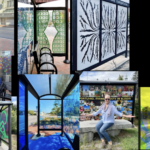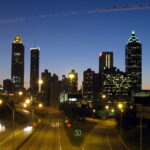The TRANSIT – Creative Placemaking with Europe in Baltimore sought to expand local ownership over two elements of transportation infrastructure: bus shelters in southeast Baltimore; and the Penn Station plaza, the space outside Baltimore’s main transportation hub in central Baltimore.
The challenge
Between 2000 and 2010, the City of Baltimore’s Hispanic or Latinx population grew 134.7%, with many choosing to reside in Southeast Baltimore neighborhoods. To respond to this demographic diversity, the Highlandtown Arts & Entertainment District and the Southeast Community Development Corporation wanted to create a placemaking intervention that was both functional and culturally relevant to the Hispanic or Latinx and other communities in southeast Baltimore.
The project
At the bus stop in southeast Baltimore, the Highlandtown Arts & Entertainment District partnered with the Maryland Transit Administration, the Creative Alliance, and Spanish artists mmmm… to create a shelter that would creatively build connections between new residents, older residents, and the bus system which is heavily used by both groups. The result was a unique bus shelter made from steel and wood, consisting of three capital letters—BUS—which have the same meaning in both English and Spanish. The creative shelter now serves as a starting point for sharing public space across languages.
At the Penn Station plaza, a concrete space designed primarily for cars to pick up and drop off train passengers, British/French parkour artists Prodigal UPG performed and taught the French movement style that consists of moving efficiently and often acrobatically through urban spaces. These performances and lessons brought new life to the desolate plaza, providing a newfound sense of ownership of the plaza for neighborhood youth and elders alike who attended weekly parkour workshops and monthly performances throughout the spring of 2014. The ephemeral nature of this work of art allowed it to be produced with far fewer signoffs than a work of permanent art would have required, thereby allowing a new approach to activation to be quickly tested.
The results
The TRANSIT projects showed that
- Public transit infrastructure can serve as a starting point for sharing public space amongst people of different cultures.
- Temporary art installations can often bypass arduous permitting processes that are required for permanent pieces.
- Transportation infrastructure can serve crucial community needs beyond the quotidian.
- Art can help create unifying transportation infrastructure
- Temporary activations of public space can have an immediate impact on activation, and can produce a lasting impact even after they are gone.
Key partners: Creative Alliance, mmmm…, Highlandtown Arts & Entertainment District, Prodigal UPG, Station North Arts & Entertainment District, Maryland Transit Administration, Baltimore City Parking Authority















